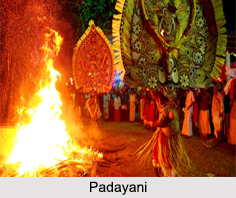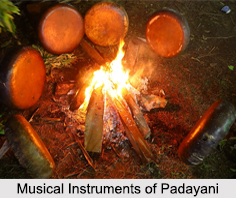 Also known as Padeni, the traditional folk dance form of Padayani is a ceremonial dance involving masks. It is an art form that blends music, dance, theatre, satire, facial masks, and paintings. This annual ritualistic theatre art form of Padayani is performed in the Bhadrakali temples of central Travancore, especially in the Pathanamthitta district of Kerala. The rituals performed in Padayani are a symbolic act for pleasing the Goddess Bhadrakali.
Also known as Padeni, the traditional folk dance form of Padayani is a ceremonial dance involving masks. It is an art form that blends music, dance, theatre, satire, facial masks, and paintings. This annual ritualistic theatre art form of Padayani is performed in the Bhadrakali temples of central Travancore, especially in the Pathanamthitta district of Kerala. The rituals performed in Padayani are a symbolic act for pleasing the Goddess Bhadrakali.
Etymology of Padayani
Evolved from the combination of two Malayalam words, Pada and Ani, the word Padayani means a row of soldiers or warriors. This dance form is believed to have been performed by warriors trained in Kalaripayattu, which is a South Indian martial art tradition.
Myth behind Padayani
As per Hindu mythology, the evolution of the dance form of Padayani is related to the birth of Goddess Kali, who defeated the asura named Darika. After the battle with Darika, the wrath of Goddess Kali could not be contained and to pacify her, the Gods tried to entertain her but to no avail. It was then that Padayani was performed, a ritualistic dance which commemorates the art performed by Lord Shiva and the other Gods to appease the Goddess.
 Ritual of Padayani
Ritual of Padayani
According to the Malayalam calendar, Padayani is usually performed in the months of Makaram, Kumbham, Meenam, Medam and Edavam. It is the modern form of Kolam Thullal, which is a ritual dance that is performed by the magico- medicine men of Kerala. A major attraction of Padayani is the song associated with it, which are in Malayalam and have been sung since the ancient times. Traditionally only a single type of instrument called thappu, which is a special percussion instrument was exclusively used in Padayani, with the songs.
The dance form of Padayani starts with heating the musical instrument of thappu, which faces the fire. It is said that the duration of the festival may vary from 7 to 28 days. Different territorial divisions of the village are represented by their leaders. They assemble in front of the temple on the first day with torches lit from the lamp in the sanctum. They proceed in a procession around the temple to the accompaniment of thappu, with cymbals keeping time is used as an accompaniment. The tappu is round and wooden, covered with very thick hide heated to the maximum to produce a high tone. On occasions when it is played without heat treatment, it is called pacha tappu.
From the third day of the festival, the masked dance commences with Ganapati kolam, painted with the face of Lord Ganapati. Among many kolams in the rich repertoire, Kalan i.e. God of death or time is prominent. Kalan appears to take away the life of the young boy Markandeya whose death was predestined at the age of 16. But through strict penance and concentrated devotion, Markandeya pleased Lord Shiva, who kills Kalan when he tries to snatch the boy`s life. The dancer performs all three roles. Accompanying vocal music describes the whole Puranic myth of Markandeya. The song describes graphically the consequences of the death of the God of death, and the dancer enacts the pangs of death suffered by Kalan. When the dancer in his possessed state collapses, stagehands sprinkle water on his face to wake him up after a while to resume the drama.
Another kolam, of Kutira or the horse, refers to the establishment of commercial relations between Kerala and Arabia in the past. Apart from the manifestation of spirits, social characters like the Brahmin landlord with his valet and the Christian ferryman make for interesting dramatic sequences in performance.
Padayani is performed mainly in the temples of the villages of Elanthoor, Kottangal, Kadammanitta, Kurampala, Kallooppara, Kadalimangalam, Thengeli and Kunnamthanam.
The ritual of Padayani transcends the boundaries of caste and religion, generating a sense of unity.




